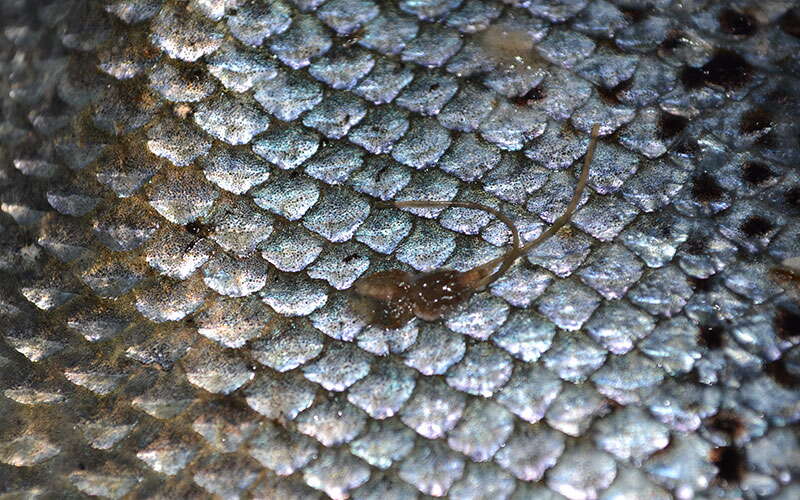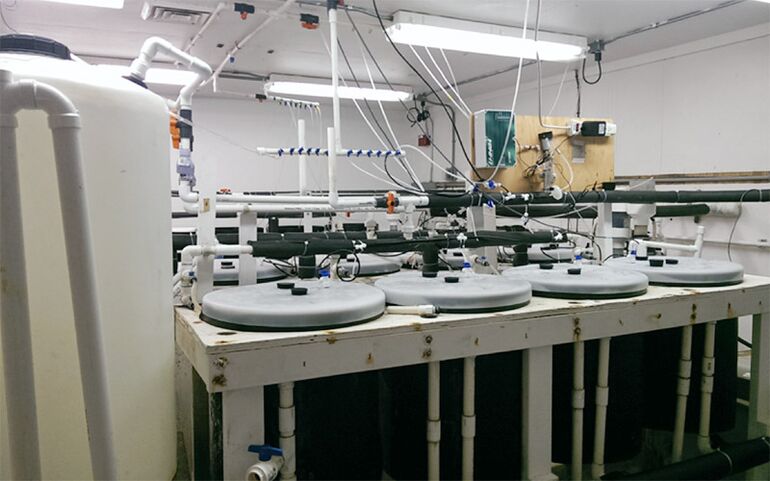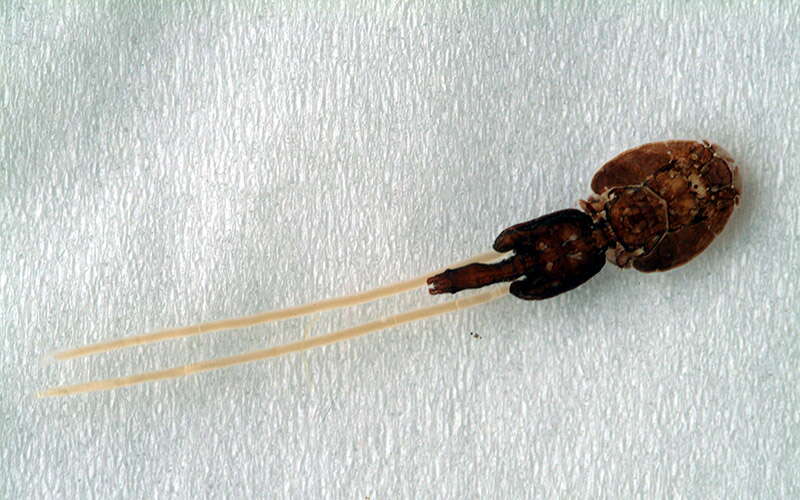
Here's how $1.4M in NOAA grants will be used to help Maine's fishing industry
 Courtesy / Aquaculture Research Institute
The combined impacts of temperature changes and acidification on lobsters will be studied in an enclosed system developed at UMaine's Aquaculture Research Institute.
Courtesy / Aquaculture Research Institute
The combined impacts of temperature changes and acidification on lobsters will be studied in an enclosed system developed at UMaine's Aquaculture Research Institute.
Sea lice infestation costs the salmon aquaculture industry an estimated at $15 million annually in the United States and $740 million globally — and remains the greatest barrier to continuing and expanding salmon aquaculture in the oceans.
That’s the industry context underscoring the relevance of the $725,365 grant awarded to a University of Maine team to study potential new treatments for sea lice infestation.
The grant is one of two to UMaine that were announced recently by National Sea Grant College, a program of the National Oceanic and Atmospheric Administration. Both projects are expected to further advance the development of a sustainable marine and coastal aquaculture industry in the United States, according to a NOAA news release.
Heather Hamlin, Deborah Bouchard and Ian Bricknell of UMaine’s Aquaculture Research Institute will research an integrated approach to addressing sea lice control in the commercial culture of Atlantic salmon in sea pens. The project will address gaps in knowledge of sea lice biology and control methods, such as integrated pest management, and new, ecologically sensitive chemical compounds and their effects on nontarget species, such as lobsters.
Voracious pests

Hamlin explained to Mainebiz that sea lice are tiny marine crustaceans.
“They latch onto the salmon skin and then they grow,” said Hamlin. “The problem is, once they get big enough or in high enough numbers, they start to erode the fish’s protective mucus carrier, and start eating through the skin down to the muscle.”
That’s harmful to the infested fish’s health. It’s also a problem for the salmon industry because the fish, which don’t necessarily die from an infestation, aren’t attractive to consumers.
Sea lice consumption doesn’t hurt humans, she noted.
Hamlin noted that land-based salmon farms, such as the ones being proposed for Belfast and Bucksport, are not vulnerable to sea lice.
No. 1 problem

According to a Maine Department of Marine Resources fact sheet, Maine uses an integrated pest management program for sea lice. Farms are monitored and if any exceed a predetermined level of sea lice, it treats the fish with a sea lice control drug in their food. The treatment is administered under the direction of a veterinarian and under the supervision of the U.S. Food and Drug Administration and the U.S. Department of Agriculture.
The program also requires that farms lie fallow between production crops in order to reduce any chance of lice transferring from one group of fish to the next. Because the farms lie fallow, and because they must treat early before sea lice get to be a significant problem or move from farm to farm, use of the sea lice drug is minimal.
Nevertheless, said Hamlin, sea lice are growing more prevalent in Maine and around the world.
“It’s the No. 1 problem faced by our industry in Maine and arguably the world,” she said.
Modelers are working on trying to understand why they’re more prevalent, she said.
The study will examine whether other treatments on the market can be used, and whether they might impact non-target species, especially lobsters — an outcome to be avoided, she said.
“We need to make sure we’re protecting both industries,” she said.
The project will also try to find compounds that are ecologically friendly, and will examine how quickly salmon develop resistance to current treatments. Hamlin couldn’t go into detail about potential new treatments, but said they include botanicals. The goal is not necessarily to kill sea lice, but to deter them.
The study will occur over a three-year period. Sea lice sampling in the natural environment will take place throughout that time. The project will also look at the effect of treatments on lobsters, in both the larval and adult stages.
Hamlin will convene meetings with industry and regulators to understand the factors that prevent adoption of new sea lice control techniques and identify other impediments faced by the salmon industry.
“We want to convene all kinds of stakeholders – commercial producers, regulators and scientists all together in one place,” she said. “We want to facilitate change and in a collaborative way.”
Impact of changes in the oceans
Through a second grant of $192,774 from NOAA’s Saltonstall-Kennedy Grant Program, Hamlin and her collaborators will examine the role of elevated ocean temperatures combined with ocean acidification as potential causes of lobster population declines.
According to Hamlin’s grant application, “The Gulf of Maine is experiencing changes in temperature and acidification at rates greater than nearly anywhere else in the world, underscoring an urgent need to understand possible outcomes and identify threats to population resilience. For more than a decade, lobsters have been experiencing a dramatic population decline in Southern New England, and should this decline spread into the Gulf of Maine, it would threaten the livelihood and culture of fishing communities, and the multi-billion dollar industry they support.”
The study is expected to be useful in fishery management and as a tool to predict temperatures likely to cause lobster population declines, which could allow stakeholders to make informed decisions to mitigate economic losses.
Previous studies have examined the impact of temperature changes and acidification on lobsters separately, but not in combination, Hamlin said. The study will likely begin in spring 2019.
“The combination can be a lot more problematic than just one,” she said.
Satellite tech
NOAA Sea Grant also awarded $692,216 to fund development and use of new high-resolution satellite technology expected to promote productive and sustainable oyster, scallop, and mussel aquaculture. The study will be led by Damian Brady and Emmanuel Boss of UMaine’s School of Marine Sciences.
According to the release, two of the biggest decisions made by prospective shellfish farmers are what species to grow, and where to grow it. New tools and technologies are available to help aquaculturists, but they need help accessing and interpreting information.
Building on the success of previous Sea Grant work that established satellite imagery as an effective tool for aquaculture site selection, the team will use maps they’ve developed to refine a bivalve growth model to identify optimal growing locations for American oysters, European oysters, scallops and mussels. They will share their findings in training sessions with growers and other practitioners interested in using satellite imagery for siting shellfish farms in their own region.
The projects were among the 22 awarded out of 100 proposals requesting $48 million in federal grant funds. The projects include a 50% match by nonfederal partners.
Between February 2017 and January 2018, Sea Grant invested $1.4 million in aquaculture research, technology transfer and outreach in Maine and reported $5.9 million in economic impacts, including support of 123 businesses and 200 jobs.













Comments